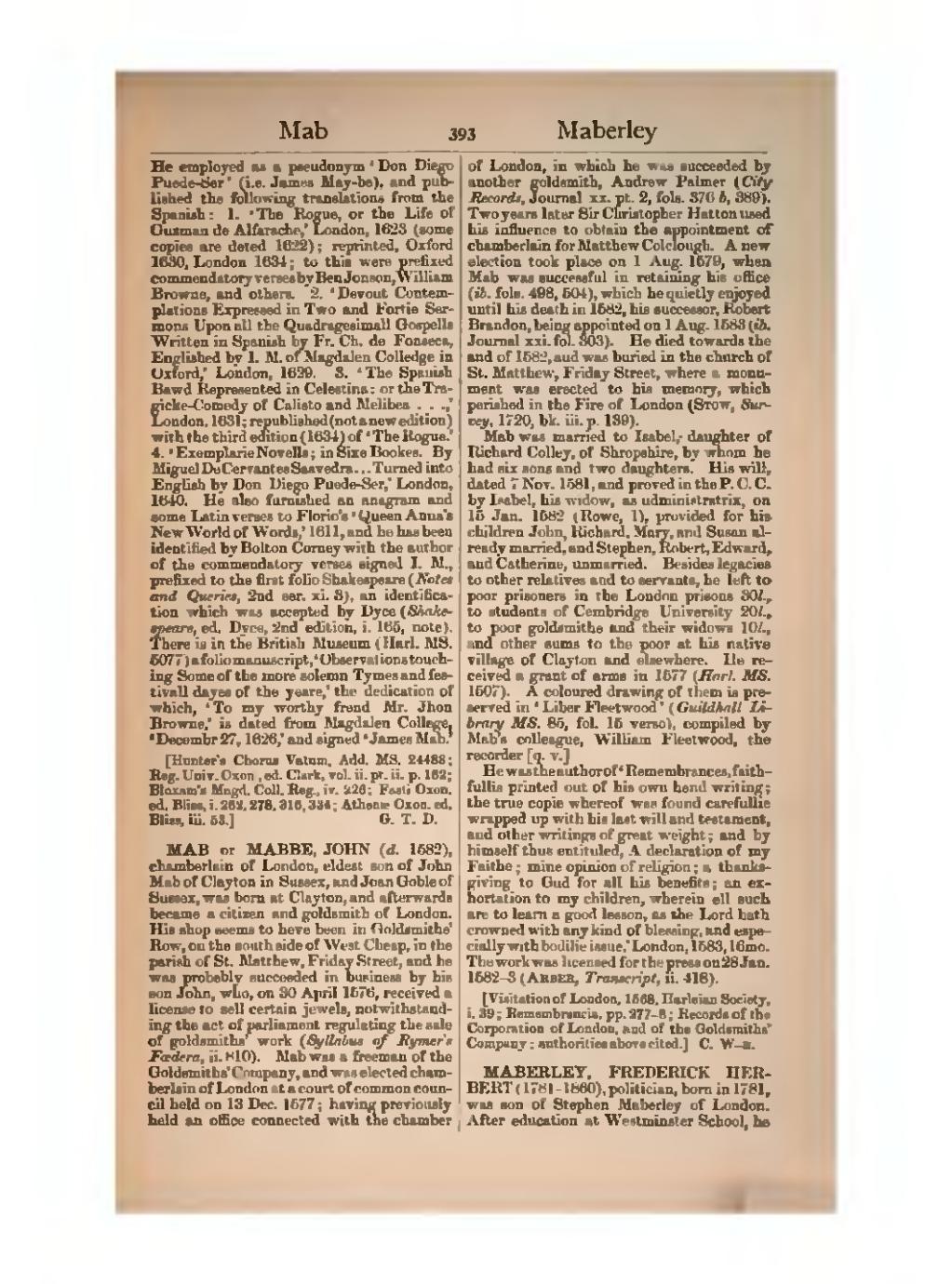He employed as a pseudonym ‘Don Diego Puede-Ser’ (i.e. James May-be), and published the following translations from the Spanish: 1. ‘The Rogue, or the Life of Guzman de Alfarache,’ London, 1623 (some copies are dated 1622); reprinted, Oxford 1630, London 1634; to this were prefixed commendatory verses by Ben Jonson, William Browne, and others. 2. ‘Devout Contemplations Expressed in Two and Fortie Sermons Upon all the Quadragesimall Gospells Written in Spanish by Fr. Ch. de Fonseca, Englished by I. M. of Magdalen Colledge in Oxford,’ London, 1629. 3. ‘The Spanish Bawd Represented in Celestina: or the Tragicke-Comedy of Calisto and Melibea …,’ London, 1631; republished (not a new edition) with the third edition (1634) of ‘The Rogue’; reprinted in ‘Tudor Translations,’ 1894, and in Routledge's ‘Library of English Novelists,’ 1908. 4. ‘Exemplarie Novells; in Sixe Bookes. By Miguel De Cervantes Saavedra. .... Turned into English by Don Diego Puede-Ser,’ London, 1640. He also furnished an anagram and some Latin verses to Florio's ‘Queen Anna's New World of Words,’ 1611. According to Bolton Corney, he wrote commendatory verses signed I. M., prefixed to the first folio Shakespeare (Notes and Queries, 2nd ser. xi. 3); his authorship was accepted by Dyce, (Shakespeare, ed. Dyce, 2nd edition, i. 165). A folio MS. (Harl. MS. 5077), ‘Observations touching Some of the more solemn Tymes and festivall dayes of the yeare,’ is dedicated ‘To my worthy frend Mr. Jhon Browne’ (dedication dated from Magdalen College, ‘Decembr 27, 1626,’ and signed ‘James Mab’).
[Hunter's Chorus Vatum, Add. MS. 24488; Reg. Univ. Oxon., ed. Clark, vol. ii. pt. ii. p. 162; Bloxam's Magd. Coll. Reg., iv. 226; Fasti Oxon. ed. Bliss, i. 262, 278, 316, 334; Athenæ Oxon. ed. Bliss, iii. 53.]
MAB or MABBE, JOHN (d. 1582), chamberlain of London, eldest son of John Mab of Clayton in Sussex, and Joan Goble of Sussex, was born at Clayton, and afterwards became a citizen and goldsmith of London. His shop seems to have been in Goldsmiths' Row, on the south side of West Cheap, in the parish of St. Matthew, Friday Street, and he was probably succeeded in business by his son John, who, on 30 April 1576, received a license to sell certain jewels, notwithstanding the act of parliament regulating the sale of goldsmiths' work (Syllabus of Rymer's Fœdera, ii. 810). Mab was a freeman of the Goldsmiths' Company, and was elected chamberlain of London at a court of common council held on 13 Dec. 1577; having previously held an office connected with the chamber of London, in which he was succeeded by another goldsmith, Andrew Palmer (City Records, Journal xx. pt. 2, fols. 376 b, 389). Two years later Sir Christopher Hatton used his influence to obtain the appointment of chamberlain for Matthew Colclough. A new election took place on 1 Aug. 1579, when Mab was successful in retaining his office (ib. fols. 498, 504), which he quietly enjoyed until his death in 1582, his successor, Robert Brandon, being appointed on 1 Aug. 1583 (ib. Journal xxi. fol. 303). He died towards the end of 1582, and was buried in the church of St. Matthew, Friday Street, where a monument was erected to his memory, which perished in the Fire of London (Stow, Survey, 1720, bk. iii. p. 139).
Mab was married to Isabel, daughter of Richard Colley, of Shropshire, by whom he had six sons and two daughters. His will, dated 7 Nov. 1581, and proved in the P.C.C. by Isabel, his widow, as administratrix, on 15 Jan. 1582 (Rowe, 1), provided for his children John, Richard, Mary, and Susan already married, and Stephen, Robert, Edward, and Catherine, unmarried. Besides legacies to other relatives and to servants, he left to poor prisoners in the London prisons 30l., to students of Cambridge University 20l., to poor goldsmiths and their widows 10l., and other sums to the poor at his native village of Clayton and elsewhere. He received a grant of arms in 1577 (Harl. MS. 1507). A coloured drawing of them is preserved in ‘Liber Fleetwood’ (Guildhall Library MS. 85, fol. 15 verso), compiled by Mab's colleague, William Fleetwood, the recorder [q. v.]
He was the author of ‘Remembrances, faithfullie printed out of his own hand writing; the true copie whereof was found carefullie wrapped up with his last will and testament, and other writings of great weight; and by himself thus entituled, A declaration of my Faithe; mine opinion of religion; a thanksgiving to God for all his benefits; an exhortation to my children, wherein all such are to learn a good lesson, as the Lord hath crowned with any kind of blessing, and especially with bodilie issue,’ London, 1583, 16mo. The work was licensed for the press on 28 Jan. 1582–3 (Arber, Transcript, ii. 418).
[Visitation of London, 1568; Harleian Society, i. 39; Remembrancia, pp. 277–8; Records of the Corporation of London, and of the Goldsmiths' Company; authorities cited.]
MABERLEY, FREDERICK HERBERT (1782–1860), politician, born 18 April 1782, was son of Stephen Maberley of London. After education at Westminster School, he
